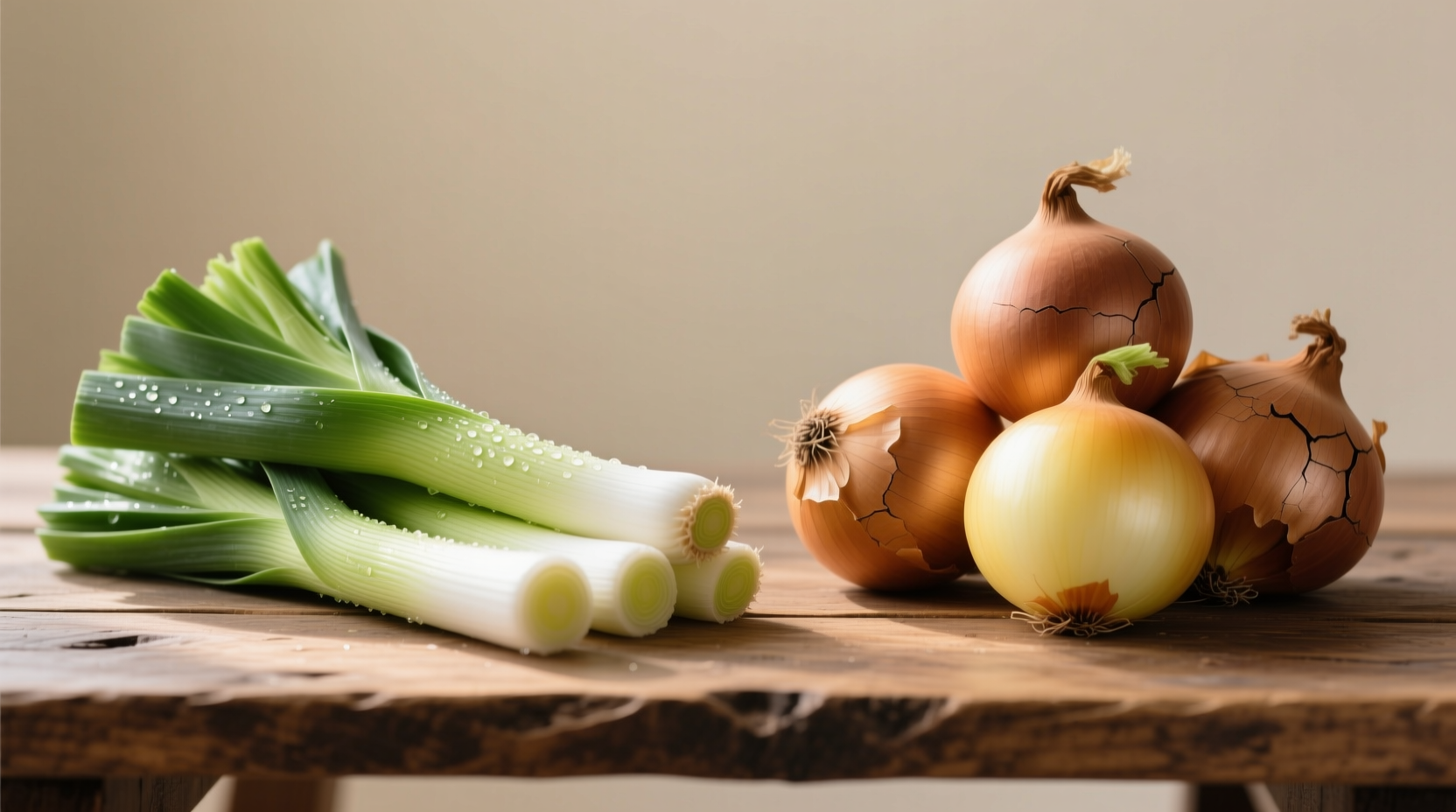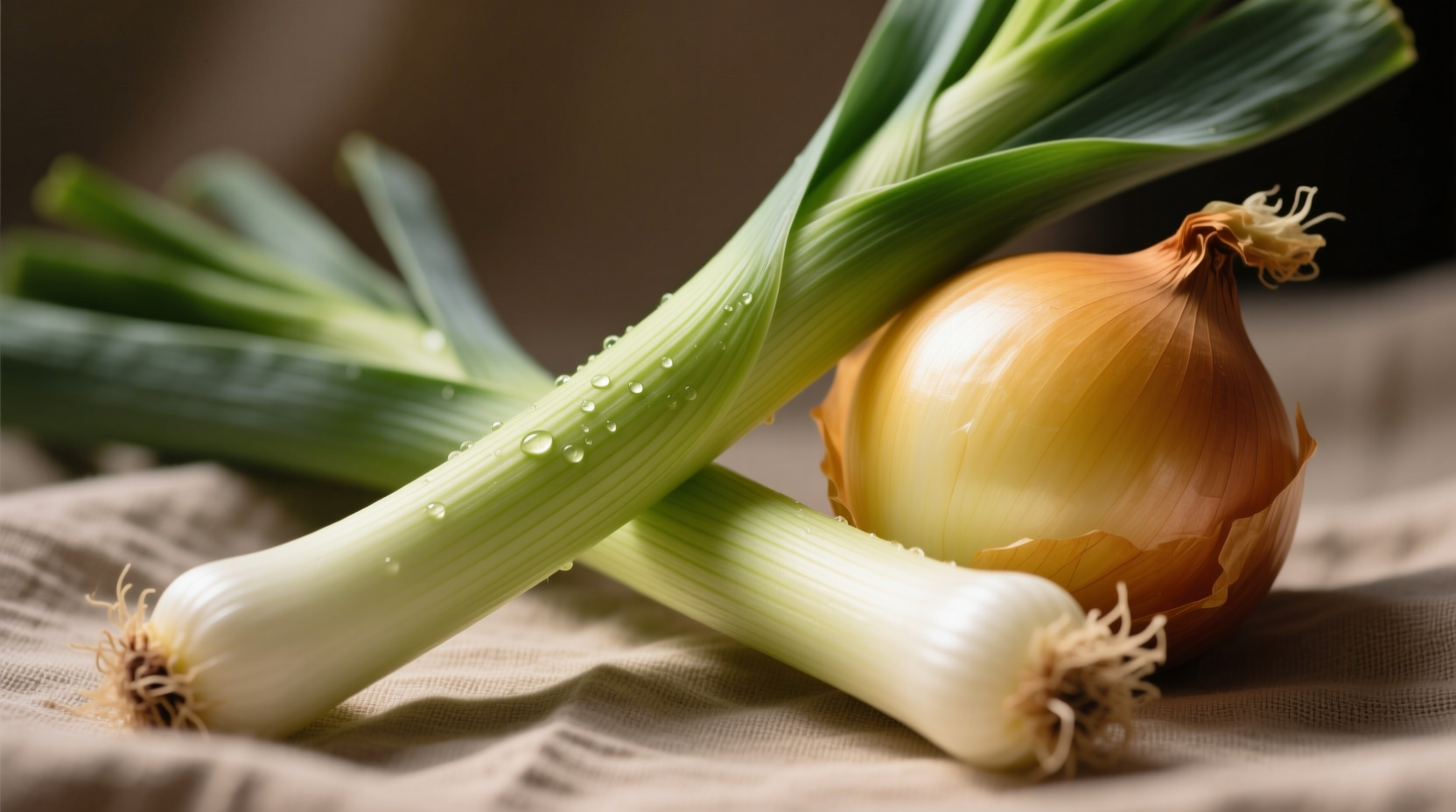Discover exactly when to reach for leeks versus onions in your cooking, how to properly substitute one for the other, and why understanding these differences will transform your culinary results. This guide delivers practical, chef-tested insights you can apply immediately in your kitchen.
Understanding the Fundamental Differences
Many home cooks mistakenly treat leeks and onions as interchangeable ingredients, but their botanical distinctions create significant impacts on flavor development and texture in cooking. Both belong to the Allium genus, but represent different species with unique chemical compositions that respond differently to heat and preparation methods.
| Characteristic | Leeks | Onions (Yellow) |
|---|---|---|
| Botanical Classification | Allium ampeloprasum | Allium cepa |
| Flavor Profile | Mild, sweet, delicate (resembles scallion tops) | Sharp, pungent, becomes sweet when caramelized |
| Texture When Cooked | Tender, silky strands | Soft, melts into dishes |
| Best Cooking Methods | Simmering, gentle sautéing, braising | Caramelizing, roasting, high-heat sautéing |
| Substitution Ratio | 1:1 by volume (for mild dishes) | 1 leek = ½ onion (for stronger flavors) |
Visual Identification Guide
Recognizing these vegetables at the market prevents costly mistakes in your shopping. Leeks feature long, cylindrical stalks with dark green tops fading to light green and white bases. Unlike onions, they don't form bulbs but rather layered stalks. Onions develop distinctive rounded bulbs with papery outer skins ranging from white to purple.

When Substitution Works (and When It Doesn't)
Understanding the context boundaries for substituting leeks and onions prevents culinary disasters. The USDA Agricultural Research Service confirms that while both contain similar sulfur compounds responsible for their characteristic aromas, the concentration differs significantly—onions contain approximately 3-4 times more volatile sulfur compounds than leeks.
Successful substitutions:
- Use leeks in potato soup instead of onions for a more delicate flavor profile
- Substitute young green onions for leeks in quiches when leeks are unavailable
- Combine both in French onion soup for layered flavor complexity
Problematic substitutions:
- Replacing onions with leeks in salsa (leeks become too soft)
- Using onions instead of leeks in a delicate seafood bisque (overpowers subtle flavors)
- Substituting raw onions for raw leeks in salads (onions are too harsh)
Proper Preparation Techniques
Many cooks waste perfectly good leeks because they don't know how to clean them properly. The layered structure traps sand between the leaves. Professional chefs recommend the "halve and soak" method: cut leeks lengthwise, separate the layers, and soak in cold water to release trapped dirt.
For onions, the "root-end preservation technique" minimizes tears: leave the root end intact while cutting to reduce the release of lachrymatory factor synthase, the enzyme responsible for eye irritation. This technique is supported by research from the New Zealand Institute for Plant and Food Research.
Nutritional Comparison and Health Benefits
Both vegetables offer impressive nutritional profiles, but with different strengths. According to USDA FoodData Central, raw leeks provide 20% more vitamin K and 15% more folate per serving than yellow onions, while onions contain higher levels of quercetin, a powerful antioxidant.
Leeks particularly shine in cardiovascular health support. A 2022 study published in the Journal of Agricultural and Food Chemistry found that the unique combination of kaempferol and allicin compounds in leeks demonstrates significant anti-inflammatory effects on blood vessels.
Storage and Shelf Life Guidance
Maximize freshness with proper storage techniques:
- Leeks: Store unwashed in the refrigerator's crisper drawer for up to 2 weeks. Do not trim roots or remove outer layers until ready to use.
- Onions: Keep in a cool, dark, well-ventilated space (not the refrigerator) for 1-2 months. Never store near potatoes, which release gases that accelerate onion spoilage.
Common Culinary Mistakes to Avoid
Even experienced cooks make these errors when working with allium vegetables:
- Mistake: Using the entire leek including dark green tops in delicate dishes
Solution: Reserve dark green parts for stocks and only use white and light green sections for main dishes - Mistake: Adding onions too early in long-cooking dishes
Solution: For stews and braises, add onions halfway through cooking to preserve their structure - Mistake: Substituting leeks 1:1 for onions in all recipes
Solution: Adjust ratios based on desired flavor intensity—use half the amount of leeks when replacing onions in robust dishes
Seasonal Availability and Selection Tips
Leeks reach peak flavor during cooler months (October-March), while onions maintain consistent quality year-round due to proper storage capabilities. When selecting leeks, choose firm stalks with crisp, vibrant green tops—avoid any with yellowing or slimy spots. For onions, look for firm bulbs with dry, papery skins and no soft spots.
Expert Cooking Applications
Professional chefs leverage the unique properties of each vegetable:
- Leeks: Create a fond de cuisine by gently sweating leeks in butter as the flavor base for sauces and soups
- Onions: Build flavor complexity through the "onion triple threat"—raw for crunch, sautéed for sweetness, and caramelized for depth
For the perfect French omelet, many chefs combine both: sweat leeks first for their delicate sweetness, then add a small amount of finely diced onion for aromatic complexity without overwhelming the eggs.











 浙公网安备
33010002000092号
浙公网安备
33010002000092号 浙B2-20120091-4
浙B2-20120091-4